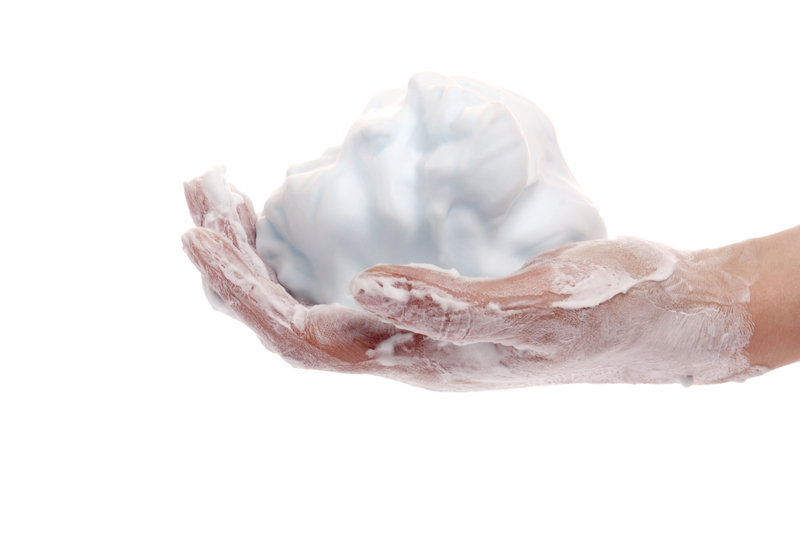From Start to Finish: Tenant's Guide to End of Tenancy Cleaning
Posted on 23/08/2025
From Start to Finish: Tenant's Guide to End of Tenancy Cleaning
Moving out of a rented property brings a blend of emotions--excitement, nervousness, and often, stress. One of the pivotal aspects of this transition is end of tenancy cleaning. Whether you are a seasoned renter or new to the process, understanding what's expected can mean the difference between a smooth move and unexpected headaches, especially when it comes to retrieving your deposit. This comprehensive tenant's guide to end of tenancy cleaning covers everything you need to know, ensuring you leave your rented space spotless and keep your landlord happy.

What is End of Tenancy Cleaning?
End of tenancy cleaning refers to the thorough deep clean of your rental property before you move out. It's often stipulated in tenancy agreements, serving as the benchmark for the condition you should leave the property in. A successful post-tenancy clean can help secure the return of your deposit and maintain a good relationship with your landlord or letting agent.
Why is End of Lease Cleaning Important?
- Deposit Retrieval: Most landlords expect the property to be as clean as when you moved in. Meeting these expectations maximizes the chance you'll get your full deposit back.
- Legal Obligations: All tenants are generally responsible for cleaning the space as per their tenancy agreement.
- Smooth Handover: A spotless property sets the right tone for final inspections and avoids last-minute disputes.
- Reference for Future Rentals: A positive cleaning record can make it easier to rent another property in the future.
Planning Your End of Tenancy Cleaning: A Step-by-Step Approach
Proper planning ensures you don't miss anything during your end of tenancy clean. Here's a streamlined guide to organizing your tasks:
Step 1: Review Your Tenancy Agreement
Your tenancy agreement usually outlines specific cleaning obligations. Review it carefully, making note of any special requirements (like professional carpet or oven cleaning).
Step 2: Gather Cleaning Supplies
- Multi-surface cleaners
- Disinfectant sprays
- Microfiber cloths and sponges
- Mop, bucket, broom, and vacuum cleaner
- Oven and hob cleaner
- Descaling solutions for taps and showerheads
- Gloves and masks for protection
Having all necessary supplies in advance streamlines the cleaning process.
Step 3: Document the Property's Original and Current Condition
Use your check-in inventory as a reference. Take before-and-after photos to avoid any disputes over the property's state after cleaning.
Step 4: Schedule Your Cleaning Timeline
- Plan a full day (at least) for thorough cleaning, depending on property size.
- Work from the top of the house/building to the bottom, and from back rooms to the main entrance.
- Leave the floors as the last task.
Room-by-Room End of Tenancy Cleaning Checklist
For a comprehensive move out cleaning, you need to address every room. Here's an in-depth checklist for each area:
Kitchen
- Oven, Hob, and Extractor Fan: Remove grease and burnt-on residue. Use a dedicated oven cleaner if needed.
- Fridge/Freezer: Defrost and clean both inside and out. Leave doors open to avoid mould.
- Cabinets and Drawers: Wipe inside and out, removing all food and crumbs.
- Sinks and Taps: Descale taps, scrub the sink, and polish for shine.
- Counters and Surfaces: Sanitise all worktops and splashbacks.
- Microwave and Other Appliances: Clean thoroughly, inside and outside.
- Floors: Sweep and mop, paying special attention to corners and under appliances.
Bathroom
- Toilet, Bathtub, Shower, and Sink: Remove scale, stains, and soap residue. Disinfect all surfaces.
- Tiles and Grout: Clean and scrub grout lines; remove any mould or mildew.
- Mirrors and Glass: Wipe down until streak-free.
- Extractor Fan: Dust and clean for proper airflow.
- Floors: Thoroughly mop and disinfect.
Bedrooms and Living Area
- Wardrobes and Drawers: Wipe inside and out.
- Skirting Boards, Doors, and Handles: Dust and scrub thoroughly.
- Carpets and Flooring: Vacuum throughout; consider professional carpet cleaning if required by your lease.
- Windows and Sills: Clean inside (and outside if accessible).
- Light Switches and Sockets: Wipe carefully with a damp cloth.
- Walls: Remove marks with a soft sponge; repair minor scuffs.
Hallways and Entrances
- Doors and Handles: Clean and polish.
- Hooks, Coat Racks: Dust and wipe down.
- Floors: Sweep, vacuum, and mop as appropriate.
Focusing on Commonly Missed Areas
When it comes to thorough tenancy cleaning, certain spots are frequently forgotten. Attention to these details can make a significant difference at inspection:
- Behind and under furniture and appliances
- Vent covers and extractor fans
- Light fixtures and lampshades
- Picture rails, cornices, and skirting boards
- Window tracks and curtain rails
- Showerhead (descaling)
*Don't forget to empty all rubbish bins and dispose of waste appropriately.
DIY Vs Professional End of Tenancy Cleaning
Deciding between doing your end of lease cleaning yourself or hiring professionals depends on time, budget, and your tenancy agreement.
- DIY Cleaning: Cheaper, but time-consuming. Good for small flats or if you enjoy cleaning.
- Professional Cleaning Services: Ideal for large properties, tight schedules, or when professional cleaning is required for deposits. Many landlords require a receipt as proof of professional service.
Pro Tip: If opting for a professional end of tenancy cleaning service, make sure they offer a deposit back guarantee and have positive reviews. Always confirm exactly what's included in their checklist.
Common Mistakes to Avoid in Tenancy Cleaning
- Overlooking the Inventory List: You may miss repairs or cleaning requirements specific to your property.
- Not Checking Appliances: Forgotten microwaves or hidden crumbs in the oven often cause deductions.
- Rushing the Cleaning Process: Haste leads to missed areas and lower standards.
- Ignoring Professional Requirements: Some tenancies require professional steam or carpet cleaning with a valid receipt.
Essential End of Tenancy Cleaning Tips for Tenants
- Start Early: Give yourself enough time, ideally a week before moving out.
- Work Room by Room: Focus on one space at a time for efficiency.
- Use the Right Products: Avoid abrasive cleaners that might damage surfaces.
- Let in Fresh Air: Open windows for proper ventilation while cleaning.
- Check for Repairs: Fix minor issues like loose hinges or scuffed paint where possible.
Frequently Asked Questions About End of Tenancy Cleaning
Do I Have to Hire a Professional Cleaning Service?
Unless your tenancy agreement states otherwise, you can do the cleaning yourself. However, for carpet cleaning or oven cleaning, some landlords may demand professional receipts.
How Long Does End of Tenancy Cleaning Take?
Depending on the size and condition of your property, a detailed clean can take anywhere from 4 to 12 hours--or more.
What Happens if I Don't Clean Properly?
If cleaning doesn't meet the landlord or letting agent's standards, they may deduct from your security deposit to cover professional end of tenancy cleaning costs.
Can I Be Charged for Normal Wear and Tear?
No, you're not responsible for natural deterioration through normal use. However, damage, stains, or excessive grime that wasn't present when you moved in can lead to charges.
End of Tenancy Cleaning: A Move-Out Timeline
To help you manage your end of rental cleaning, here's a suggested timeline:
- Two Weeks Before: Review lease, arrange any required professional cleaning, gather supplies.
- One Week Before: Begin cleaning less-used areas, such as spare rooms or attic spaces.
- Three Days Before: Defrost freezer, clean behind and under furniture. Patch up minor repairs.
- Day Before/Move Out Day: Deep clean kitchen, bathroom, hallways, and floors. Empty bins and remove all personal belongings.
- After Cleaning: Take dated photos of the cleaned property as evidence.
Sustainable End of Tenancy Cleaning: Eco-Friendly Tips
Nowadays, many tenants prefer eco-friendly cleaning. Here's how you can leave the place sparkling clean and environmentally conscious:
- Use Natural Cleaning Agents: Vinegar, baking soda, and lemon work wonders on most surfaces.
- Opt for Reusable Cloths: Microfiber cloths can be washed and reused, minimizing waste.
- Avoid Harsh Chemicals: They're not only harmful to the environment but can also leave residues.
- Recycle and Dispose: Separate rubbish and recycle wherever possible.
Remember: Using eco-friendly methods can be both effective and considerate to the next tenants!

Getting Your Deposit Back: What Landlords Look For
Landlords and agents typically assess the property using an inventory from the start of your tenancy. Their checklist focuses on:
- Cleanliness: All rooms and appliances must be clean and tidy, as per the move-in standard.
- Repairs: Any damage caused beyond normal wear and tear should be fixed or reported.
- Removal of Personal Items: Ensure nothing is left behind, apart from what came with the property.
Consider being present during the final inspection to discuss any issues directly, and present your cleaning receipts if any were required.
Final Thoughts: Your Key to a Smooth Handover
A carefully managed end of tenancy clean is your passport to a stress-free move, full deposit return, and a strong reference for future rentals. By organizing your cleaning tasks and paying attention to detail, you'll leave your residence as you first found it--if not better. Whether you decide to take the DIY route or enlist a professional end of tenancy cleaning company, the ultimate goal remains the same: a happy landlord, a clean property, and no unwelcome surprises after move-out.
Ready to clean? Use this guide as your checklist from start to finish. By dedicating time and care now, you'll ensure your rental journey ends on a high note--clean, clear-handed, and carefree.





